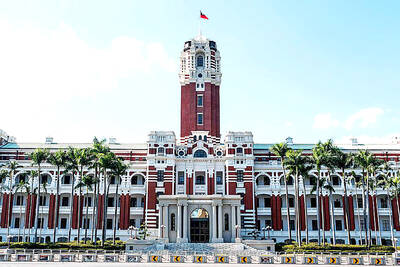A new study by Robert Kaplan — to be printed later this month in Foreign Affairs magazine — concludes that Washington and Taipei should work together to make the prospect of war seem “prohibitively costly” to Beijing.
“The United States could then maintain its credibility with its allies by keeping Taiwan functionally independent until China became a more liberal society,” Kaplan says.
According to RAND, a major Washington-based think tank, by the year 2020 the US will no longer be able to defend Taiwan from a Chinese attack.
China, the RAND report says, will by that time be able to defeat the US in a war in the Taiwan Strait even if the US has F-22s, two carrier strike groups and continued access to the Kadena Air Base in Okinawa, Japan.
Kaplan, a senior fellow at the Center for a New American Security, writes that in the 21st century, China will project hard power abroad primarily through its navy.
“The Chinese navy sees little but trouble in what it calls the ‘first island chain’: the Korean Peninsula, the Kuril Islands, Japan (including the Ryukyu Islands), Taiwan, the Philippines, Indonesia and Australia,” Kaplan says.
Aiming to block the US Navy from entering the East China Sea and other Chinese coastal waters, China has modernized its destroyer fleet and has plans to acquire one or two aircraft carriers and could field a submarine force larger than the US Navy’s — which has 75 submarines in commission — within 15 years.
“As part of its effort to control its offshore waters in the Taiwan Strait and the East China Sea, China is also improving its mine-warfare capability, buying fourth-generation jet fighters from Russia and deploying 1,500 Russian surface-to-air missiles along its coast,” Kaplan says.
China’s aim, he says, is to dissuade the US Navy from getting between the first island chain and the Chinese coast whenever and wherever it wants.
“Since the ability to shape one’s adversary’s behavior is the essence of power, this is evidence that a Greater China is being realized at sea as on land,” he says.
And most important to the advent of a Greater China is the future of Taiwan.
“The issue of Taiwan is often discussed in moral terms: Beijing talks about the need to consolidate the national patrimony and unify China for the good of all ethnic Chinese; Washington talks about preserving this model democracy. But the real issue is something else. Taiwan is an ‘unsinkable aircraft carrier’ midway up China’s seaboard,” he writes.
Kaplan says that if Taiwan returned “to the bosom” of China, the Chinese navy would not only be in an advantageous strategic position vis-a-vis the first island chain, but would be free to project power beyond it to an unprecedented degree.
“China’s strategy to deny the US Navy entry into certain waters is designed not only to keep US forces away generally, but also, specifically, to foster its dominance over Taiwan,” he says in the study.
Beijing, he adds, is preparing to envelop Taiwan not just militarily, but economically and socially.
“If the US simply abandons Taiwan to Beijing, then Japan, South Korea, the Philippines, Australia and other US allies in the Pacific Ocean, as well as India and even some African states, will begin to doubt the strength of Washington’s commitments,” Kaplan says.
Strengthening US air and sea power in Oceania would be a compromise approach.
“This approach would ensure that China paid a steep price for any military aggression against Taiwan. It would also allow the United States to scale back its so-called legacy bases on the first island chain but nonetheless allow US ships and planes to continue to patrol the area,” he writes.
“The very fact of China’s rising economic and military power will exacerbate US-Chinese tensions in the years ahead. The United States, the hegemon of the Western Hemisphere, will try to prevent China from becoming the hegemon of much of the Eastern Hemisphere. This could be the signal drama of the age,” he says.

The CIA has a message for Chinese government officials worried about their place in Chinese President Xi Jinping’s (習近平) government: Come work with us. The agency released two Mandarin-language videos on social media on Thursday inviting disgruntled officials to contact the CIA. The recruitment videos posted on YouTube and X racked up more than 5 million views combined in their first day. The outreach comes as CIA Director John Ratcliffe has vowed to boost the agency’s use of intelligence from human sources and its focus on China, which has recently targeted US officials with its own espionage operations. The videos are “aimed at

STEADFAST FRIEND: The bills encourage increased Taiwan-US engagement and address China’s distortion of UN Resolution 2758 to isolate Taiwan internationally The Presidential Office yesterday thanked the US House of Representatives for unanimously passing two Taiwan-related bills highlighting its solid support for Taiwan’s democracy and global participation, and for deepening bilateral relations. One of the bills, the Taiwan Assurance Implementation Act, requires the US Department of State to periodically review its guidelines for engagement with Taiwan, and report to the US Congress on the guidelines and plans to lift self-imposed limitations on US-Taiwan engagement. The other bill is the Taiwan International Solidarity Act, which clarifies that UN Resolution 2758 does not address the issue of the representation of Taiwan or its people in

US Indo-Pacific Commander Admiral Samuel Paparo on Friday expressed concern over the rate at which China is diversifying its military exercises, the Financial Times (FT) reported on Saturday. “The rates of change on the depth and breadth of their exercises is the one non-linear effect that I’ve seen in the last year that wakes me up at night or keeps me up at night,” Paparo was quoted by FT as saying while attending the annual Sedona Forum at the McCain Institute in Arizona. Paparo also expressed concern over the speed with which China was expanding its military. While the US

SHIFT: Taiwan’s better-than-expected first-quarter GDP and signs of weakness in the US have driven global capital back to emerging markets, the central bank head said The central bank yesterday blamed market speculation for the steep rise in the local currency, and urged exporters and financial institutions to stay calm and stop panic sell-offs to avoid hurting their own profitability. The nation’s top monetary policymaker said that it would step in, if necessary, to maintain order and stability in the foreign exchange market. The remarks came as the NT dollar yesterday closed up NT$0.919 to NT$30.145 against the US dollar in Taipei trading, after rising as high as NT$29.59 in intraday trading. The local currency has surged 5.85 percent against the greenback over the past two sessions, central